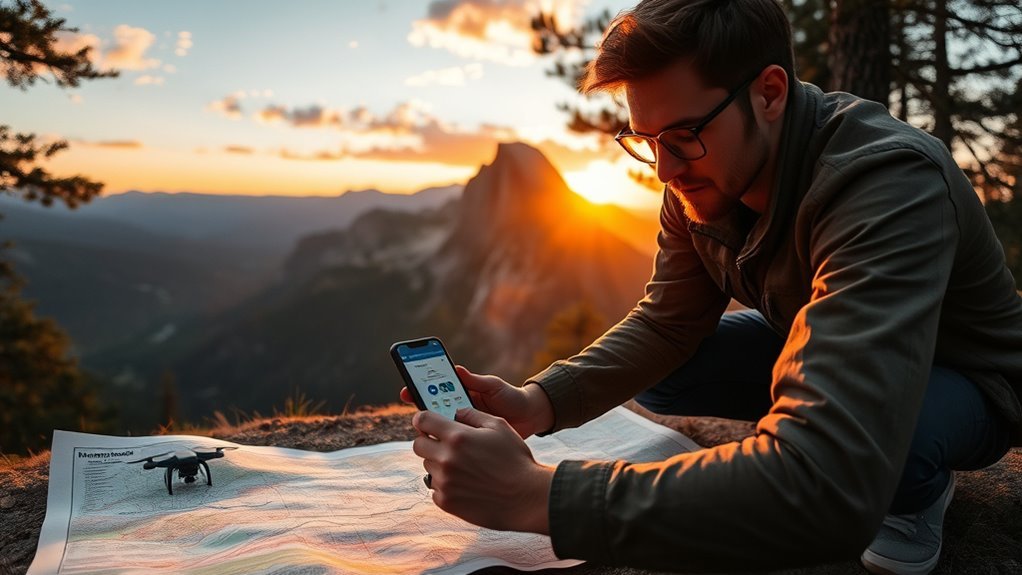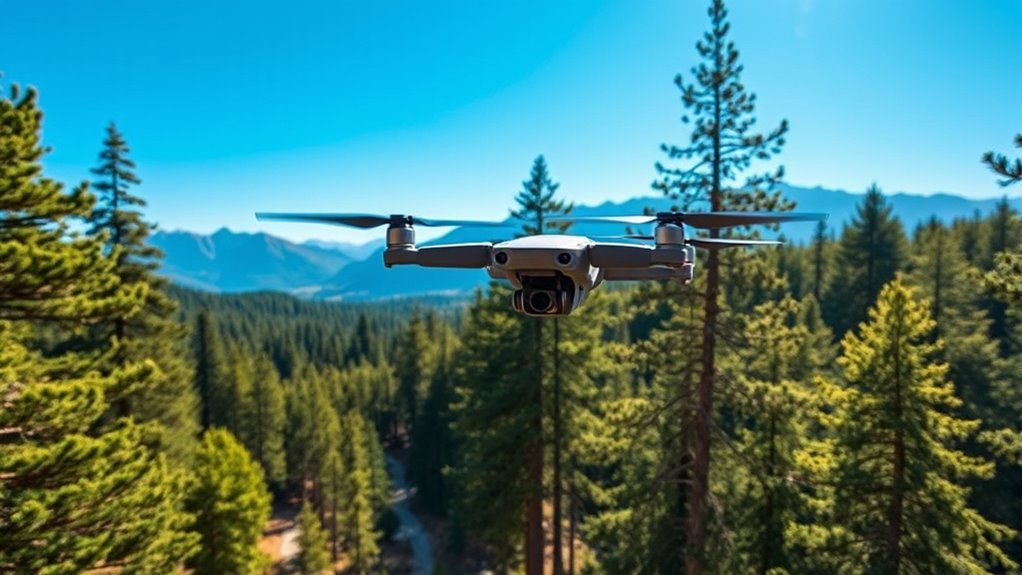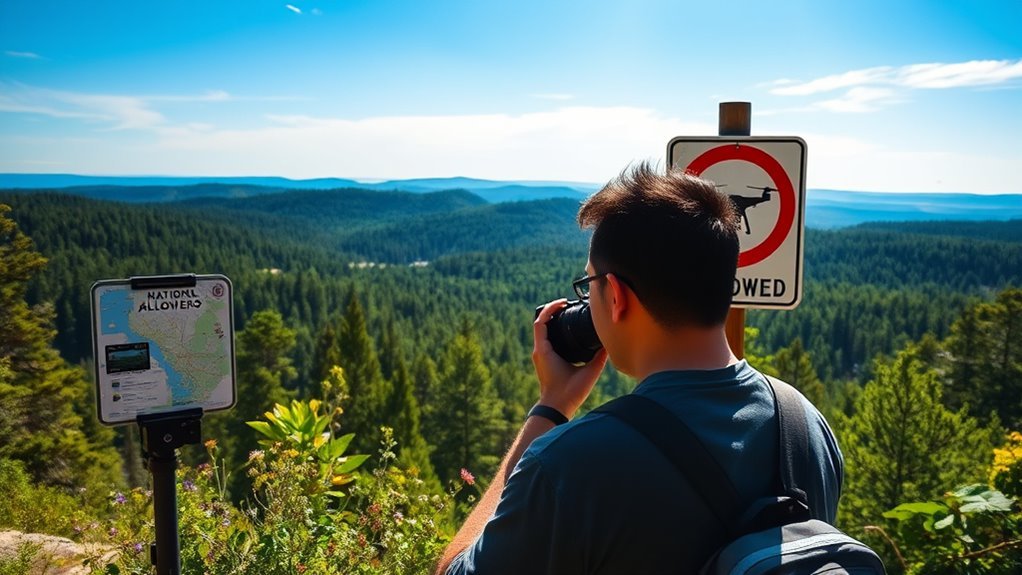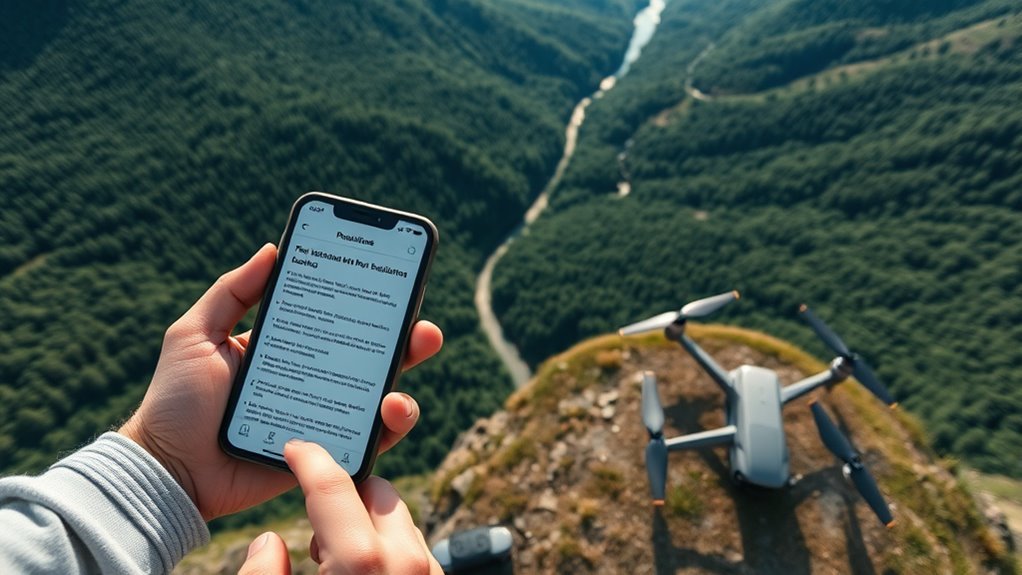To check if drones are allowed in national parks, you need to review specific regulations set by each park. Drones are often banned to protect wildlife and preserve natural landscapes. Start by visiting official park websites for updated information or contact park authorities directly for specific guidelines and permit details. Remember, these rules can vary greatly between parks, so it’s vital to familiarize yourself to guarantee compliance and enhance your visit. There are more important aspects to take into account as well.
Understanding National Park Regulations

Although many people enjoy the thrill of flying drones, understanding the regulations governing their use in national parks is essential for both safety and preservation. National park regulations often ban drone usage entirely, aiming to protect wildlife, natural landscapes, and the experience of other visitors. These rules reflect a commitment to maintaining the park’s integrity and ensuring that everyone can enjoy its beauty without disruption. Violating these regulations can lead to fines and potential legal action, so it’s vital to familiarize yourself with specific park policies before taking off. By respecting these guidelines, you not only uphold the law but also contribute to the conservation efforts that keep our national parks pristine for future generations.
Researching Specific Park Policies

How can you guarantee that your drone flying plans align with national park regulations? Start by researching park specific rules regarding drone usage. Each national park has its own set of guidelines, often shaped by local wildlife, landscape, and visitor safety concerns. Visit the park’s official website or contact the visitor center directly to get accurate, up-to-date information. Pay special attention to any restrictions on flight zones, times, and necessary permits. Understanding these policies not only assures compliance but also enhances your experience, allowing you to respect the natural environment while pursuing your passion. Remember, what works for one park might not apply elsewhere, so thorough research is essential before you take to the skies.
Utilizing Online Resources and Tools

Wondering where to find the best online resources for drone regulations in national parks? Start by exploring official websites like the National Park Service, which often provide extensive guidelines on drone usage. You can also access online databases that compile drone regulations specific to each park, offering a quick reference for your planning. Websites like FAA.gov can clarify federal regulations that affect your drone flying. Additionally, forums and community groups dedicated to drone enthusiasts can share firsthand experiences and updates on park policies. By utilizing these online tools, you’ll equip yourself with the knowledge to navigate the regulations, ensuring your freedom to fly doesn’t come with unexpected consequences. Always double-check these resources before your drone adventure!
Contacting Park Authorities
Since regulations can vary considerably between different national parks, contacting park authorities directly is crucial for obtaining the most accurate and up-to-date information regarding drone usage. You should utilize various contact methods, such as phone calls, emails, or official park websites, to reach out. Ask about specific park permits required for drone operation, as many parks have stringent rules governing their use. Don’t hesitate to clarify any uncertainties about restrictions, designated flying zones, or necessary documentation. Being proactive in this communication not only guarantees compliance but also enhances your overall experience in the park. Ultimately, connecting with park authorities empowers you to enjoy your freedom while respecting the regulations that protect these natural wonders.
Respecting Wildlife and Natural Habitats
After you’ve clarified the regulations with park authorities, it’s important to contemplate the impact of drone usage on wildlife and natural habitats. Drones can cause significant wildlife disturbance, disrupting mating, feeding, and nesting behaviors. To guarantee habitat protection, consider the following factors:
| Impact Type | Description |
|---|---|
| Wildlife Disturbance | Noise and movement can frighten animals. |
| Habitat Protection | Drones may intrude on protected areas. |
| Long-term Effects | Prolonged disturbances can lead to population declines. |
Frequently Asked Questions
Are There Specific Drone Weight Limits for National Parks?
You’ll find that drone regulations often include specific weight restrictions. It’s essential to check the regulations for each national park, as these rules can vary widely, impacting your ability to fly freely and responsibly.
Can I Use Drones for Commercial Purposes in Parks?
You can’t use drones for commercial purposes in national parks without specific permits. Drone regulations often prohibit such activities to protect wildlife and preserve natural landscapes, so it’s essential to check local guidelines before proceeding.
Do I Need a Special Permit to Fly a Drone?
Flying a drone’s like maneuvering through a maze; you need to know the rules. You’ll often need a special permit due to drone regulations, ensuring flying safety while granting you the freedom to explore the skies responsibly.
Are There Designated Areas for Drone Flying in Parks?
You’ll often find that designated areas for drone flying vary by park. It’s essential to review drone regulations and park policies before flying, ensuring you’re compliant and enjoying your freedom responsibly within those spaces.
What Are the Penalties for Flying Drones in Restricted Areas?
Flying a drone in restricted areas is like dancing with shadows; you risk hefty fines imposed and strict enforcement actions. Know the laws, or you might find your freedom clipped by unexpected consequences.

